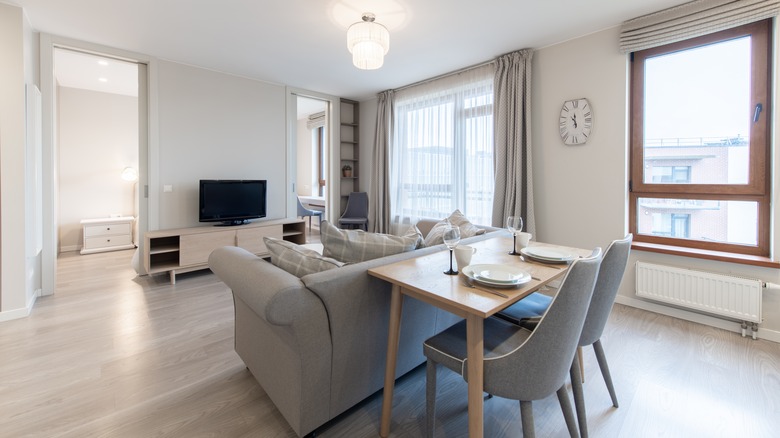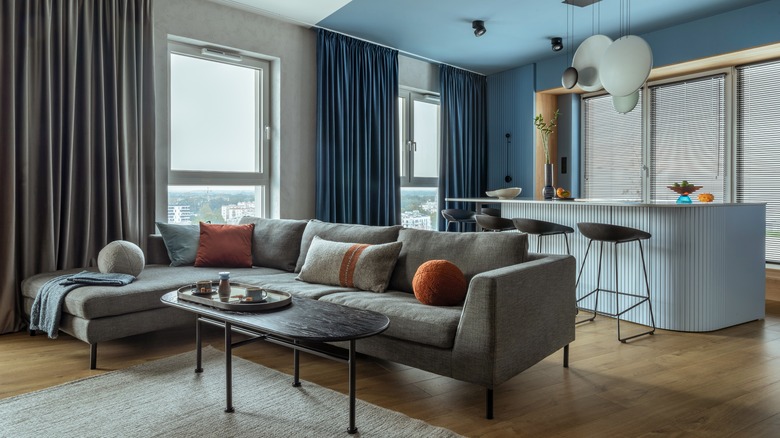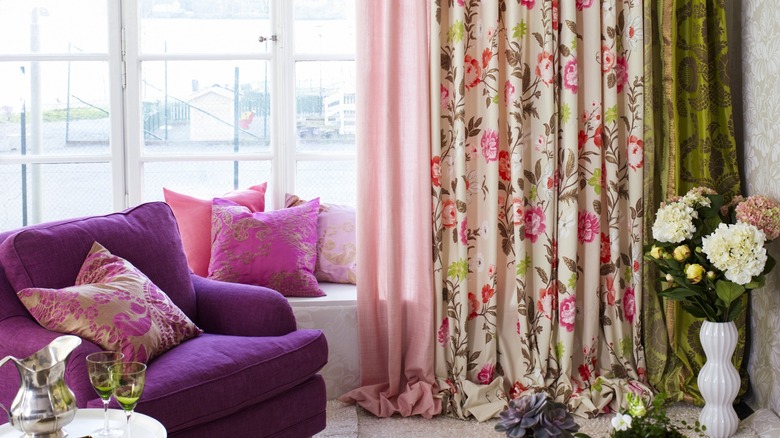The Compelling Reason Why You Should Be Mixing Your Curtain Styles
Window dressings are an important component in just about any room's design. They filter harsh sunlight, give you more privacy, and can even help to improve your sleep quality. In addition to these functional uses, they're also one of the easiest ways to inject more style into your space. Because they're so large, your window dressings can make almost as much impact as something like your wall color or flooring. When choosing the perfect curtains for your space, it's important to decide on a style that aligns with your personal taste and complements the rest of your décor, but settling on just one can be a struggle. Thankfully, there's one easy technique that can give you more freedom with your choices: mixing your curtain styles.
Curtains are large swaths of fabric, so if you completely outfit all of your windows in the exact same material, the space can start to feel a bit stuffy or bland. By trying out different curtain styles but keeping a few consistencies throughout, you have the chance to play around with your design and break up the monotony. If you're not careful, however, your window dressings might start to look more mismatched than intended, so it's important to keep a few simple rules in mind when you're shopping around.
Why you should mix your window treatments
Mixing your window treatments can be beneficial for one simple reason: it gives your eyes a break. If you have a room with a lot of windows, the same curtains over and over will leave you with a wall of the same shape and color. This isn't a problem if you enjoy the consistency, but too much repetition of the same thing can start to make a space feel monotonous and unnecessarily formal. An entirely white room filled with the same linen textures, for example, might technically match, but it will feel staged and stuffy. On the other hand, a room chock-full of colorful items with no relation to each other might carry a lot of personality, but it can become overwhelming, perhaps leaning too far into the cluttercore design trend.
In large rooms and open concept spaces, changing up the curtains can also break up the space and create visual zones. Different windows might also have different treatment needs. For example, a western window needs thicker drapes to block out afternoon rays, but a dark northern window could benefit from sheer, lightweight curtains. Thankfully, it doesn't take an interior design genius to strike this balance. Creating a room that feels comfortable but still stylish is all about mixing and matching with intention. There's plenty of room to play around with different arrangements, but if you're able to create a link between the two curtains through their color, texture, or style, you're almost guaranteed to end up with a positive result.
How to create this look in your space
If you want to mix your curtain styles, it's necessary to make sure they work well together. The easiest way to do this is by finding what they have in common. If you have blue floral curtains on one side of the room, for example, you can pair them with a solid blue curtain on another wall to mix things up while still keeping the colorways cohesive. Carrying a repeating theme around the room like this will make it feel like everything belongs together, but it will still seem more casual and laid-back than a completely matching set. If you're feeling bold, mixing patterns can also be tons of fun. In an interview with Forbes, interior designer Chloe Warner advised, "To be successful, the prints should all be related in some way, in color or attitude, and the end result will be like a fun, zesty dinner party."
Another way to play around with this idea is by getting creative with the shape of your curtains. Floor-length panel curtains can make your room feel taller and more elongated, but they're not always convenient. Instead of using them everywhere, mix them with rollers made of a matching material in shorter windows or windows that butt up against furniture. They'll complement each other perfectly, but you'll get a subtle injection of variety to break things up. Mixing and matching might feel like an unusual way to decorate with curtains at first, but if you remember to create a connection between each selection, you shouldn't run into any issues.


